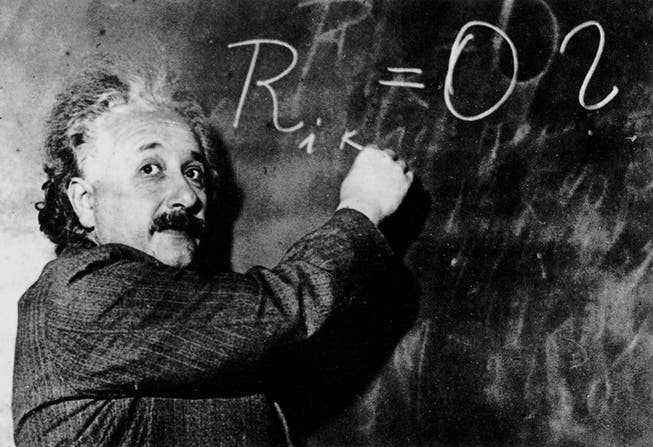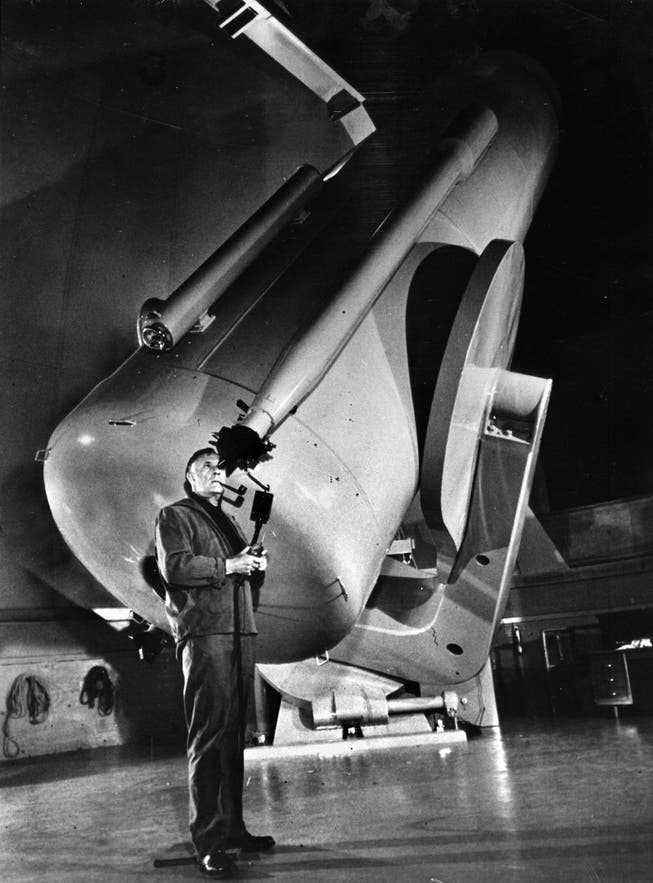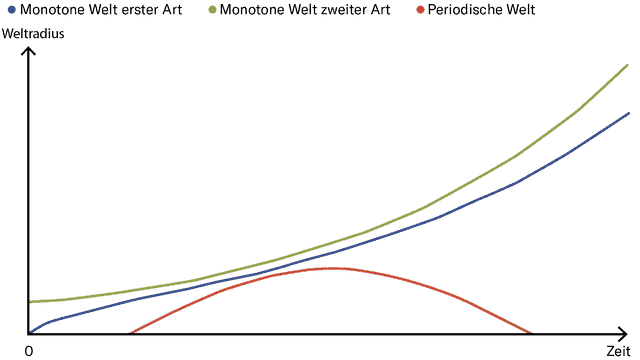A hundred years ago, the Russian mathematician Alexander Friedmann realized that the universe could be expanding. But the most famous physicist of all time didn’t want to hear about it.
A portrait of Alexander Friedmann from 1925, the year of his death.
For many centuries, the universe was considered immutable. Everything had the place that God had assigned it. In the late 1920s, however, it was recognized that the universe is by no means static, but rather expanding. Our world view had not experienced such a radical change since Copernicus – and mathematics was the inspiration.
Friedmann believes in mathematics
This discovery is usually attributed to American astronomer Edwin Hubble and Belgian priest Georges Lemaître. In fact, however, it was the Russian mathematician Alexander Friedmann who first considered the possibility of an expanding universe a hundred years ago. Friedmann relied on his mathematical instincts. And he did not shy away from defying Albert Einstein, who was already being venerated as a saint at the time.
Friedmann was born in St. Petersburg in 1888. His mother was a pianist and his father a ballet dancer. Friedmann graduated from school in 1906 and then studied mathematics and physics. After completing his studies, he accepted a position at the Aerological Observatory in St. Petersburg in 1913, where he dealt with mathematical methods of meteorology. When the First World War broke out in 1914, Friedmann volunteered for the Russian Air Squadron. Here his mathematical skills were in demand. For example, he calculated the right time to drop bombs.
After the October Revolution of 1917, Russia plunged into civil war. That is why Friedmann only found out about a completely different revolution in 1920 – a scientific one. In 1915, Albert Einstein published his General Theory of Relativity, which related gravitational force to the curvature of space and time.
With his theory, Einstein was able to correctly calculate the orbit of the planet Mercury. And he claimed that light from stars is deflected in the Sun’s gravitational field. This so-called gravitational lensing effect was confirmed in 1919 during a solar eclipse. That made Einstein famous overnight.
Einstein pays a price
In 1917, Einstein applied his theory to the entire universe. He was guided by the conviction that the cosmos is immutable and neither contracts nor expands. In fact, in 1917 he found a solution to the field equations of general relativity that reflects a static universe. She described a curved, self-contained universe in which a ray of light returns to its point of origin after a period of time.

Albert Einstein explains his General Theory of Relativity in January 1931.
However, Einstein had to pay a price for this solution. He had to add a cosmological constant to the field equations, which acts like a repulsive force over large distances. Without this additional term, Einstein’s universe was in danger of collapsing. Einstein accepted this flaw. For he loathed the idea of a changing universe.
When Friedmann began to deal with the general theory of relativity in 1920, he approached the matter much more impartially. Like Einstein, he assumed that matter is evenly distributed in the universe. However, he did not draw the conclusion that the universe must be static.
In May 1922, Friedmann submitted to the then leading “Zeitschrift für Physik” a job with the simple title “On the Curvature of Space”. In it he showed that Einstein’s field equations of the general theory of relativity allow both static and dynamic solutions. Friedmann saw no reason to discard these mathematically correct solutions just because they looked unphysical according to the understanding of the cosmos at the time.
Three scenarios of expansion
Friedmann distinguished three dynamic scenarios. In the first, the universe originates from a point and then expands into all eternity. Friedmann described this scenario as a monotonous world of the first kind. In doing so, he not only anticipated the idea of the Big Bang. In an article worth reading historian of science Ari Belenkiy argues that the monotonous world of the first kind even includes the possibility of accelerated expansion.
Friedmann was 80 years ahead of his time. In the late 1990s, astronomers discovered that distant galaxies are farther from us than they should be in a universe that is expanding at a constant rate. From this they concluded that the universe has been expanding ever faster for several billion years.
In the second scenario, the universe begins with a finite radius and then expands faster and faster. In the third scenario, as in the first, it develops out of a point. After a phase of expansion, however, it contracts again and ends as it began: in nothingness. Friedmann called the periodic world what would be called the cyclic universe today.
Friedmann was the first to find the solution to an expanding universe, says cosmologist Ruth Durrer from the University of Geneva. As a mathematician, however, he did not connect them to the real world. In fact, Friedmann is taciturn in this regard. At the end of his article he writes: “Our knowledge is completely insufficient to carry out numerical calculations and to decide which world our universe is.”
Although Friedmann left it open in which universe we live, Einstein reacted with a cold. He accused Friedmann of making a calculation error. A year later he withdrew this claim. However, he maintained that Friedmann’s dynamic solutions had no physical meaning.
Einstein’s negative attitude contributed to the fact that Friedmann’s work did not receive the attention it deserved. Also another job, in which Friedmann showed the possibility of a world with negatively curved space in 1924, went largely unnoticed. So it could happen that others took the laurels.
An experimental evidence for the expansion
One of them was the Belgian priest Georges Lemaître. Without knowing Friedmann’s publication, he showed in 1927 that an expanding universe is compatible with Einstein’s theory of relativity. However, Lemaître went one step further than Friedmann. From the observation data now available, he derived a connection between the distance and the escape velocity of galaxies. The greater their distance from Earth, the faster they move away from us. Lemaître recognized that he had experimental evidence of the expansion of the universe in his hands.
The Belgian published his work in a little-known French-language journal. One of the few who took notice was Albert Einstein. His verdict was unflattering: “Formally fine, but physically disgusting.” Einstein still wasn’t ready to abandon the idea of a static universe.
Lemaître’s work was not translated into English and recognized by a wider audience until 1931. Meanwhile, American astronomer Edwin Hubble had derived the same relationship between the speed and distance of galaxies. Unlike Lemaître, however, he did not draw the right conclusions from this. Despite this, he was long celebrated as the sole discoverer of the expanding universe. Only in 2018 did the International Astronomical Union recommend calling the Hubble Law Hubble-Lemaître Law from now on.

American astronomer Edwin Hubble at the Palomar Observatory in California.
A discovery with three fathers
Alexander Friedmann was the one who was forgotten in this dispute over priorities. The discovery of the expanding universe has several fathers, says Durrer. One could call Hubble the astronomical and Lemaître the physical father of this discovery. However, the mathematical father was undoubtedly Friedmann.
Significantly, it was Einstein who did justice to Friedmann, albeit late. After almost a decade of fierce resistance, he finally embraced the expanding universe in 1931. And he clarified that Friedmann was the first to derive this possibility mathematically.
Friedmann no longer experienced this satisfaction. He died of typhus in September 1925 at the age of 37. He probably caught the pathogen on his honeymoon in Crimea when he ate an unwashed pear.
Friedmann had already said goodbye to cosmology at this point. He now lived out his scientific curiosity differently. Just two months before his death, he ascended to an altitude of 7,400 meters in a balloon to take meteorological measurements. Nobody disputed this success.
Follow the science editors of the NZZ Twitter.

